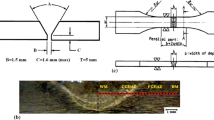Abstract
In this research, the welding characteristics of a new UHSLA steel, 35NiCrMoV123, have been studied in two general conditions (annealed and quench-tempered). Carbon equivalent value of 35NiCrMoV123 steel is near 0.9 which classifies it as a “very difficult to weld” steel. The effects of welding heat treatment cycle (preheat, interpass, and postheat) on metallurgical and mechanical properties of weldments have been investigated by tensile, impact toughness, and hardness tests, as well as optical microscopy observations. It has been observed that by employing high-temperature stress relief (600 °C), welding could be performed in annealed condition successfully. Also, the results indicate that by applying precise welding heat treating cycle (preheat, interpass, and postheat temperature at 310 °C) in order to obtain lower bainitic microstructure in HAZ, also employing high-temperature stress relief (600 °C), welding in quench-tempered condition could be successfully performed.








Similar content being viewed by others
References
A. Abdollahzadeh, A. Jafari-pirlari, and M. Barzegari, Tempered Martensite Embrittlement in a 35NiCrMoV123 Steel, J. Mater. Eng. Perform., 2005, 14, p 569–573
ASM Handbook, Vol. 6; Welding, Brazing & Soldering, 10th edn., ASM International, Material Park, Ohio, 1993, p 1055–1110
B. Irving, The Challenge of Welding Heat Treatable Alloy Steels, Weld. J., 2005, 74(2), p 43–48
C. Smith, P.G. Pistorius, and J. Wannenburg, The Effect of a Long Post Weld Heat Treatment on the Integrity of a Welded Joint in a Pressure Vessel Steel, Int. J. Pressure Vessel Piping, 1997, 70, p 183–195
Y. Tomita, Development of Fracture Toughness of Ultrahigh Strength Medium Carbon, Low Alloy Steel for Aerospace Application, Int. Mater. Rev., 2000, 45(1), p 27–37
N. Bailey, Welding Steels Without Hydrogen Cracking, 2nd edn. Abington Publishing/ASM, Cambridge
J. Neves and A. Loureiro, Fracture Toughness of Welds—Effect of Brittle Zones and Strength Mismatch, J. Mater. Process. Technol., 2004, 153-154, p 537–543
M.R. Sureh and P.P. Sinha, Study of Welding Characteristics of 0.3C-CrMoV(ESR) Ultrahigh Strength Steel, J. Matter. Sci., 2007, 42, p 5602–5612
“ASME Boiler and Pressure Vessel Code—Section 1,” The American Society of Mechanical Engineers, 2004, p 92–100
T. Branza and F. Deschaux-Beaume, Study and Prevention of Cracking During Weld-Repair of Heat-Resistant Cast Steels, J. Mater. Process. Technol., 2009, 209, p 536–547
C.-H. Lee and K.-H. Chang, Finite Element Simulation of the Residual Stresses in High Strength Carbon Steel Butt Weld Incorporating Solid-State Phase Transformation, Comput. Mater. Sci., 2009, 46, p 1014–1022
J.H. Kim, Fracture Behavior of Heat-Affected Zone in Low Alloy Steels, J. Nucl. Mater., 2001, 299(2), p 132–139
Author information
Authors and Affiliations
Corresponding author
Rights and permissions
About this article
Cite this article
Roshanghias, A., Barzegari, M., Kokabi, A.H. et al. Welding Characteristics of Ultrahigh Strength Steel in Annealed and Quench-Tempered Conditions. J. of Materi Eng and Perform 19, 963–969 (2010). https://doi.org/10.1007/s11665-009-9586-4
Received:
Revised:
Published:
Issue Date:
DOI: https://doi.org/10.1007/s11665-009-9586-4




